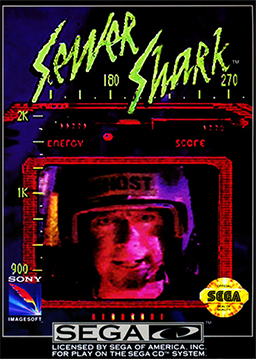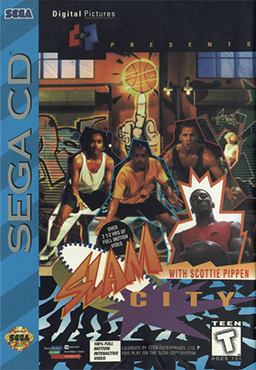
The 32X is an add-on for the Sega Genesis video game console. Codenamed "Project Mars", it was designed to expand the power of the Genesis and serve as a transitional console into the 32-bit era until the release of the Sega Saturn. The 32X uses its own ROM cartridges and has its own library of games. It was distributed under the name Super 32X in Japan and South Korea, Genesis 32X in North America, Mega 32X in Brazil, and Mega Drive 32X in all other regions.

The Sega CD, known as Mega-CD in most regions outside North America and Brazil, is a CD-ROM accessory for the Sega Genesis produced by Sega as part of the fourth generation of video game consoles. It was released on December 12, 1991, in Japan, October 15, 1992, in North America, and April 2, 1993, in Europe. The Sega CD plays CD games and adds hardware functionality such as a faster CPU and graphic enhancements such as sprite scaling and rotation. It can also play audio CDs and CD+G discs.

The 3DO Interactive Multiplayer, also referred to as simply 3DO, is a home video game console developed by The 3DO Company. Conceived by entrepreneur and Electronic Arts founder Trip Hawkins, the 3DO was not a console manufactured by the company itself, but a set of specifications, originally designed by Dave Needle and RJ Mical of New Technologies Group, that could be licensed by third parties. Panasonic produced the first models in 1993, and further renditions of the hardware were released afterwards by GoldStar, Sanyo, Creative Labs, and Samsung Electronics in 1997.
Full-motion video (FMV) is a video game narration technique that relies upon pre-recorded video files to display action in the game. While many games feature FMVs as a way to present information during cutscenes, games that are primarily presented through FMVs are referred to as full-motion video games or interactive movies.
The fifth generation era refers to computer and video games, video game consoles, and handheld gaming consoles dating from approximately October 4, 1993, to March 23, 2006. For home consoles, the best-selling console was the Sony PlayStation, followed by the Nintendo 64, and then the Sega Saturn. The PlayStation also had a redesigned version, the PSone, which was launched on July 7, 2000.

Primal Rage is a fighting game developed and released by Atari Games for arcades in 1994. The game takes place on a post-apocalyptic version of Earth called "Urth". Players control one of seven prehistoric beasts, that battle each other to determine the planet's fate. Matches feature many of the conventions of fighting games from the era, including special moves and gory finishing maneuvers. Ports were released for home video game consoles and personal computers. Efforts to perfectly emulate the arcade original have been unsuccessful due to the use of an unusual copy protection method. Toys, comics, a novel and other merchandise tie-ins were produced. More than 1.5 million copies of the game were sold.
The Control-Vision is an unreleased video game console developed by Tom Zito. It is notable for using VHS tapes rather than ROM cartridges, prompting the creation of game content which survived on into much more advanced CD-ROM platforms.
An interactive film is a video game or other interactive media that has characteristics of a cinematic film. In the video game industry, the term refers to a movie game, a video game that presents its gameplay in a cinematic, scripted manner, often through the use of full-motion video of either animated or live-action footage.
PF.Magic, Inc. was a video game developer founded in 1991 and located in San Francisco, California, United States. Though it developed other types of video games, it was best known for its virtual pet games, such as Dogz and Catz. The company was able to make extra revenue by selling plush toys under the Petz trademark. It was bought out in 1998 by Mindscape, Inc. After changing hands a few more times, Ubisoft now owns the copyright on its Petz, Oddballz and Babyz titles.
The Videogame Rating Council (V.R.C.) was introduced by Sega of America in 1993 to rate all video games that were released for sale in the United States and Canada on the Master System, Genesis, Game Gear, Sega CD, 32X, and Pico. The rating had to be clearly displayed on the front of the box, but their appearance in advertisements for the video game was strictly optional. It was later supplanted by the industry-wide Entertainment Software Rating Board.

Digital Pictures was an American video game developer founded in 1991 by Lode Coen, Mark Klein, Ken Melville, Anne Flaut-Reed, Kevin Welsh and Tom Zito.

Tomcat Alley is an interactive movie FMV video game developed by The Code Monkeys for Sega CD. It was the first Sega CD game to feature extensive full screen, full motion video. It was later released, with higher quality video, for Windows-based PCs. A 32X version was also in development, but never released.

Corpse Killer is a horror-themed rail shooter developed and published by Digital Pictures for the Sega CD, Sega CD 32X, 3DO, Sega Saturn, Windows 95 and Macintosh computers. An interactive variation on the zombie film genre, it utilizes live-action full motion video in a format similar to other games developed by Digital Pictures. Reviews for the game were mixed, generally criticizing the repetitive gameplay and low video quality, though many reviewers enjoyed the campy nature of the cutscenes. Corpse Killer was the first CD game released for the Sega 32X. It was later remastered for Steam, PlayStation 4 and Nintendo Switch.

Sewer Shark is a first-person rail shooter video game, and is the first on a home console to use full motion video for its primary gameplay. It was originally slated to be the flagship product in Hasbro's Control-Vision video game system, which would use VHS tapes as its medium. However, Hasbro cancelled the Control-Vision platform, and Digital Pictures later developed the game for the Sega CD expansion unit. Sewer Shark is one of the first titles for the Sega CD and one of its best-selling games, leading Sega to eventually bundle it with Sega CD units. It was later ported and released for the 3DO in 1994. A port was also planned for the SNES-CD, but that system was cancelled.

Wheel of Fortune is an American television game show created by Merv Griffin, premiering in 1975 with a syndicated version airing in 1983. Since 1986, the syndicated version has been adapted into various video games spanning numerous hardware generations. Most versions released in the 20th century were published by GameTek, which filed for Chapter 11 bankruptcy protection in 1998.

The Sega Genesis, also known as the Mega Drive outside North America, is a 16-bit fourth generation home video game console developed and sold by Sega. It was Sega's third console and the successor to the Master System. Sega released it in 1988 in Japan as the Mega Drive, and in 1989 in North America as the Genesis. In 1990, it was distributed as the Mega Drive by Virgin Mastertronic in Europe, Ozisoft in Australasia, and Tectoy in Brazil. In South Korea, it was distributed by Samsung Electronics as the Super Gam*Boy and later the Super Aladdin Boy.

Slam City with Scottie Pippen is the first FMV basketball video game. It was developed by Digital Pictures for the PC and CD-ROM-based video game consoles such as the Sega CD. Scottie Pippen stars in the game, and performed the theme song. Ron Stein, who had previously directed the video footage for Prize Fighter, directed the video footage for the game. A 3DO Interactive Multiplayer version was announced but never released.

Supreme Warrior is a full-motion video (FMV) beat 'em up game developed by Digital Pictures. It was released for the 3DO Interactive Multiplayer and Sega CD in November 1994 in North America and in early 1995 in Europe, with subsequent releases in 1995 for the 32X, Macintosh, and Windows. The game is themed as a kung fu film where the player has to fight off opponents to protect half of a magical mask.

Loadstar: The Legend of Tully Bodine is a video game developed and published by Rocket Science Games for the Sega CD in 1994 and MS-DOS compatible operating systems in 1995.

On December 9, 1993, and March 4, 1994, members of the combined United States Senate Committees on Governmental Affairs and the Judiciary held congressional hearings with several spokespersons for companies in the video game industry including Nintendo and Sega, involving violence in video games and the perceived impacts on children. The hearing was a result of concerns raised by members of the public on the 1993 releases of Night Trap, Mortal Kombat and later Doom which was released after the first hearing. Besides general concerns related to violence in video games, the situation had been inflamed by a moral panic over gun violence, as well as the state of the industry and an intense rivalry between Sega and Nintendo.

















